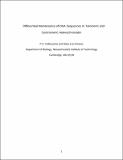| dc.contributor.author | DeBaryshe, P. G. | |
| dc.contributor.author | Pardue, Mary-Lou | |
| dc.date.accessioned | 2013-01-11T18:56:26Z | |
| dc.date.available | 2013-01-11T18:56:26Z | |
| dc.date.issued | 2010-11 | |
| dc.date.submitted | 2010-09 | |
| dc.identifier.issn | 0016-6731 | |
| dc.identifier.uri | http://hdl.handle.net/1721.1/76257 | |
| dc.description.abstract | Repeated DNA in heterochromatin presents enormous difficulties for whole-genome sequencing; hence, sequence organization in a significant portion of the genomes of multicellular organisms is relatively unknown. Two sequenced BACs now allow us to compare telomeric retrotransposon arrays from Drosophila melanogaster telomeres with an array of telomeric retrotransposons that transposed into the centromeric region of the Y chromosome >13 MYA, providing a unique opportunity to compare the structural evolution of this retrotransposon in two contexts. We find that these retrotransposon arrays, both heterochromatic, are maintained quite differently, resulting in sequence organizations that apparently reflect different roles in the two chromosomal environments. The telomere array has grown only by transposition of new elements to the chromosome end; the centromeric array instead has grown by repeated amplifications of segments of the original telomere array. Many elements in the telomere have been variably 5′-truncated apparently by gradual erosion and irregular deletions of the chromosome end; however, a significant fraction (4 and possibly 5 or 6 of 15 elements examined) remain complete and capable of further retrotransposition. In contrast, each element in the centromere region has lost ≥40% of its sequence by internal, rather than terminal, deletions, and no element retains a significant part of the original coding region. Thus the centromeric array has been restructured to resemble the highly repetitive satellite sequences typical of centromeres in multicellular organisms, whereas, over a similar or longer time period, the telomere array has maintained its ability to provide retrotransposons competent to extend telomere ends. | en_US |
| dc.description.sponsorship | National Institutes of Health (U.S.) (grant GM50315) | en_US |
| dc.language.iso | en_US | |
| dc.publisher | Genetics Society of America | en_US |
| dc.relation.isversionof | http://dx.doi.org/10.1534/genetics.110.122994 | en_US |
| dc.rights | Creative Commons Attribution-Noncommercial-Share Alike 3.0 | en_US |
| dc.rights.uri | http://creativecommons.org/licenses/by-nc-sa/3.0/ | en_US |
| dc.source | Pardue via Courtney Crummett | en_US |
| dc.title | Differential Maintenance of DNA Sequences in Telomeric and Centromeric Heterochromatin | en_US |
| dc.type | Article | en_US |
| dc.identifier.citation | DeBaryshe, P. G., and M.-L. Pardue. “Differential Maintenance of DNA Sequences in Telomeric and Centromeric Heterochromatin.” Genetics 187.1 (2010): 51–60. Web. | en_US |
| dc.contributor.department | Massachusetts Institute of Technology. Department of Biology | en_US |
| dc.contributor.approver | Pardue, Mary-Lou | |
| dc.contributor.mitauthor | Pardue, Mary-Lou | |
| dc.contributor.mitauthor | DeBaryshe, P. G. | |
| dc.relation.journal | Genetics | en_US |
| dc.eprint.version | Author's final manuscript | en_US |
| dc.type.uri | http://purl.org/eprint/type/JournalArticle | en_US |
| eprint.status | http://purl.org/eprint/status/PeerReviewed | en_US |
| dspace.orderedauthors | DeBaryshe, P. G.; Pardue, M.-L. | en |
| dc.identifier.orcid | https://orcid.org/0000-0002-4448-0785 | |
| mit.license | OPEN_ACCESS_POLICY | en_US |
| mit.metadata.status | Complete | |
